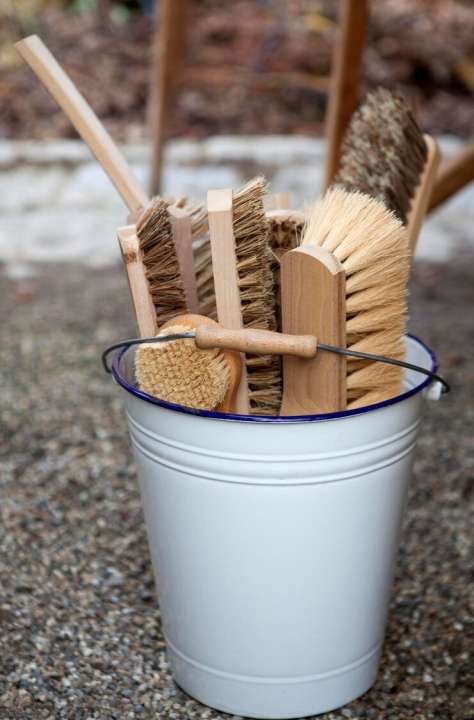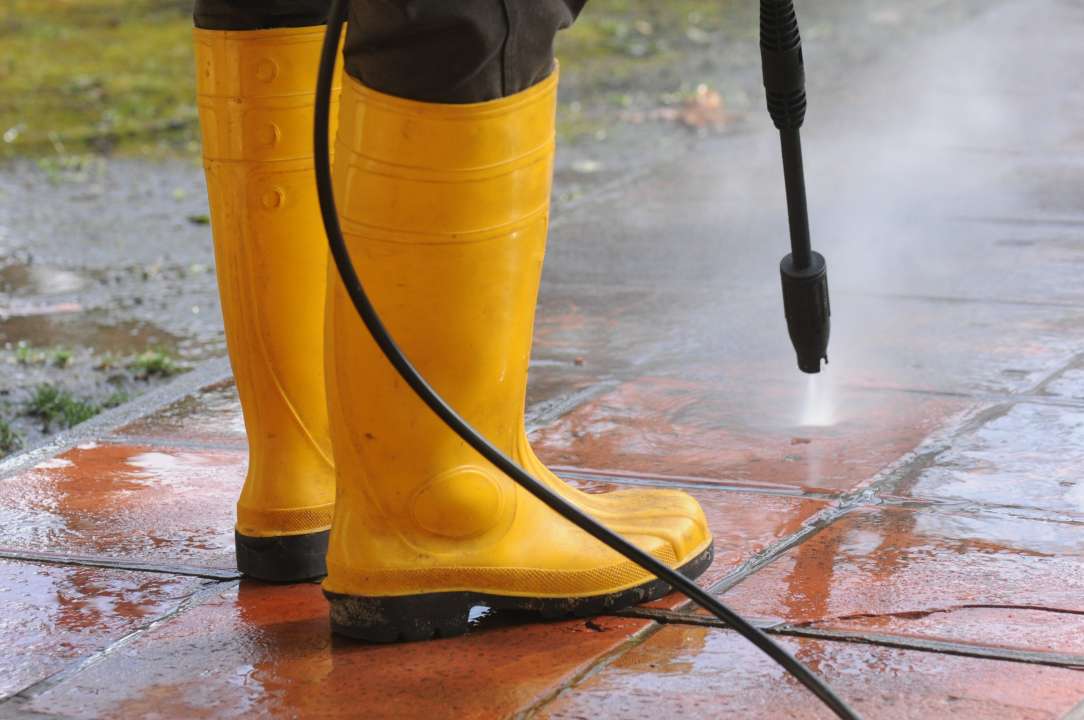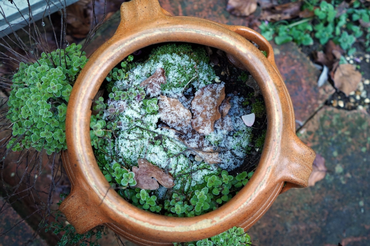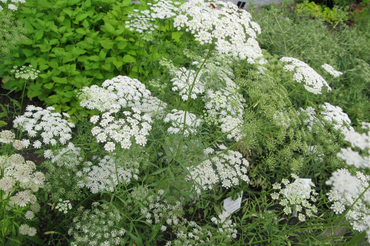Is your patio looking worse for wear after winter? Beyond being unsightly, green moss and algae can create slippery and hazardous conditions. This simple guide will walk you through spring cleaning your patio, including what to do and, importantly, what to avoid!
Ready to clean your patio? Start here
Prior to cleaning your patio, follow these essential steps:
- Clear the Patio: Remove all plants, pots, and furniture from the area. Cleaning products can be harmful or even fatal to plants. If plant removal is impossible, ensure both the plants and their surrounding soil are well-protected, preventing any product runoff into the soil.
- Sweep Thoroughly: Clear the patio surface of loose dirt, leaves, and other debris.
- Test in an Inconspicuous Spot: Before applying any cleaning product to the entire patio, test it on a small, hidden section of paving to ensure it doesn't cause damage or discoloration.

Cleaning soft stone patios with soap and water
For lightly soiled patios, particularly those crafted from softer stone like sandstone or limestone, a gentle yet effective cleaning solution often lies in the simplicity of hot, soapy water. Harsh chemicals and vigorous scrubbing can sometimes damage these more porous and delicate materials, making a mild approach the ideal first step. Here's a straightforward method to refresh your lightly marked patio:
- Mix: In a clean bucket, combine a few squirts of mild dish soap with hot (but not scalding) water. The warmth of the water helps to loosen dirt and grime, while the dish soap acts as a gentle degreaser. Ensure the soap is fully dissolved in the water.
- Apply: Liberally splash the soapy water across the entire surface of your patio, paying extra attention to areas that appear more soiled. Allow the soapy water to sit for a few minutes to begin breaking down any surface dirt and debris.
- Scrub: Using a stiff-bristled brush (avoiding overly abrasive metal brushes that could scratch softer stone), gently scrub the affected areas. Apply moderate pressure, focusing on lifting the dirt rather than grinding it into the stone. For larger areas, work in manageable sections.
- Rinse: Once you've scrubbed the patio, thoroughly rinse the entire surface with clean water. Ensure all traces of the soapy residue are washed away, as leftover soap can sometimes attract more dirt or leave a dull film. A garden hose with a spray nozzle works well for this step.
- Dry: Allow the patio to air dry completely for at least 24 hours before placing furniture or heavy items back on it. This drying time ensures that any moisture trapped within the porous stone can evaporate, preventing potential issues like algae growth or weakening of the stone over time.
- Repeat: If you encounter any stubborn stains that don't lift with the initial cleaning, you can carefully repeat the process. For particularly persistent marks, you might consider a specialised cleaner designed for natural stone, always testing it in an inconspicuous area first to ensure it doesn't cause discoloration or damage. Remember, patience and gentle methods are key when dealing with softer stone patios.
Using a pressure washer on patios
Pressure washers are highly effective for cleaning paving, but require careful handling to prevent damage to both the paving surface and the pointing. To maximise results and minimise risk, follow these guidelines:
- Begin with Gentle Power: The Low and Wide Approach:
- Start Low: Always initiate the cleaning process with your pressure washer set to its lowest possible pressure setting. This minimizes the initial impact on the surface and allows you to assess the paver's resilience. You can gradually increase the pressure if needed, but it's far better to start gently than to cause immediate damage.
- Wide Fan Spray: Opt for the fan spray nozzle rather than a concentrated jet or rotary nozzle. The fan spray distributes the water pressure over a wider area, reducing the force on any single point. Think of it like a gentle sweep rather than a focused blast. Concentrated jets can easily etch softer stones or blast away pointing.
- Respect the Distance: Creating a Safe Buffer:
- Maintain Distance: Avoid the temptation to spray from point-blank range. Keep a significant distance (at least 12-18 inches, and potentially more for softer stones) between the pressure washer nozzle and the paving surface. This allows the water pressure to dissipate slightly before impact, lessening the risk of scoring or pitting the pavers.
- Angle for Success: The 30-Degree Advantage:
- Shallow Angle: Direct the water spray at a shallow angle of approximately 30 degrees relative to the paving surface. This technique helps to lift dirt and debris away from the surface rather than forcing water directly into the pores of the stone or the joints. A perpendicular spray can be too aggressive and drive water into vulnerable areas.
- Strategic Movement: The Diagonal Sweep:
- Diagonal Pattern: Move the spray wand in a smooth, consistent, diagonal pattern across the pavers. This ensures even cleaning and prevents the creation of streaks or uneven wear.
- Avoid the Joints: Be particularly careful to avoid spraying directly along the joints between the pavers. The pointing (mortar or jointing compound) is often less robust than the pavers themselves and can be easily eroded or washed away by direct, high-pressure water. This can compromise the stability and appearance of your patio over time.

The Acid Test: Why Vinegar Can Harm Your Patio
While white vinegar frequently earns praise as a natural cleaning agent and demonstrates effectiveness in tackling various stains around the home, a word of caution arises when considering its use on paving. Many seasoned landscaping professionals specifically advise against applying vinegar to patio surfaces. The concern lies in its acidic nature; the acetic acid present in vinegar can potentially react with and degrade the composition of certain types of stone commonly used in patios, particularly limestone and concrete pavers. These materials are often porous and can be susceptible to etching or weakening upon contact with acidic substances. Therefore, to prioritize the long-term integrity and aesthetic appeal of your patio, the most prudent approach is to adhere to the reliable and time-tested method of using hot, soapy water coupled with the mechanical action of some good old-fashioned scrubbing. This gentler method effectively lifts light soiling without posing a risk to the structural integrity or surface finish of your valuable patio.
Find everything you need to revitalize your garden this spring at our garden centre in St. Albans, Hertfordshire. Visit us today!




